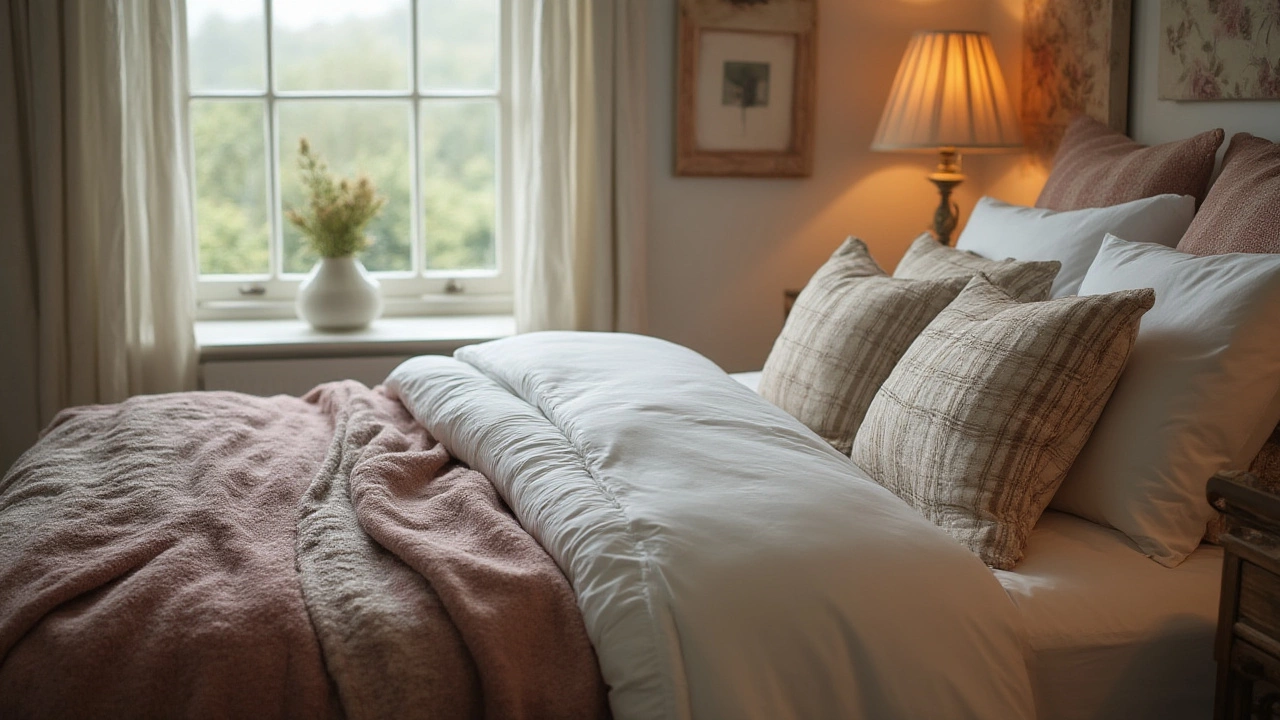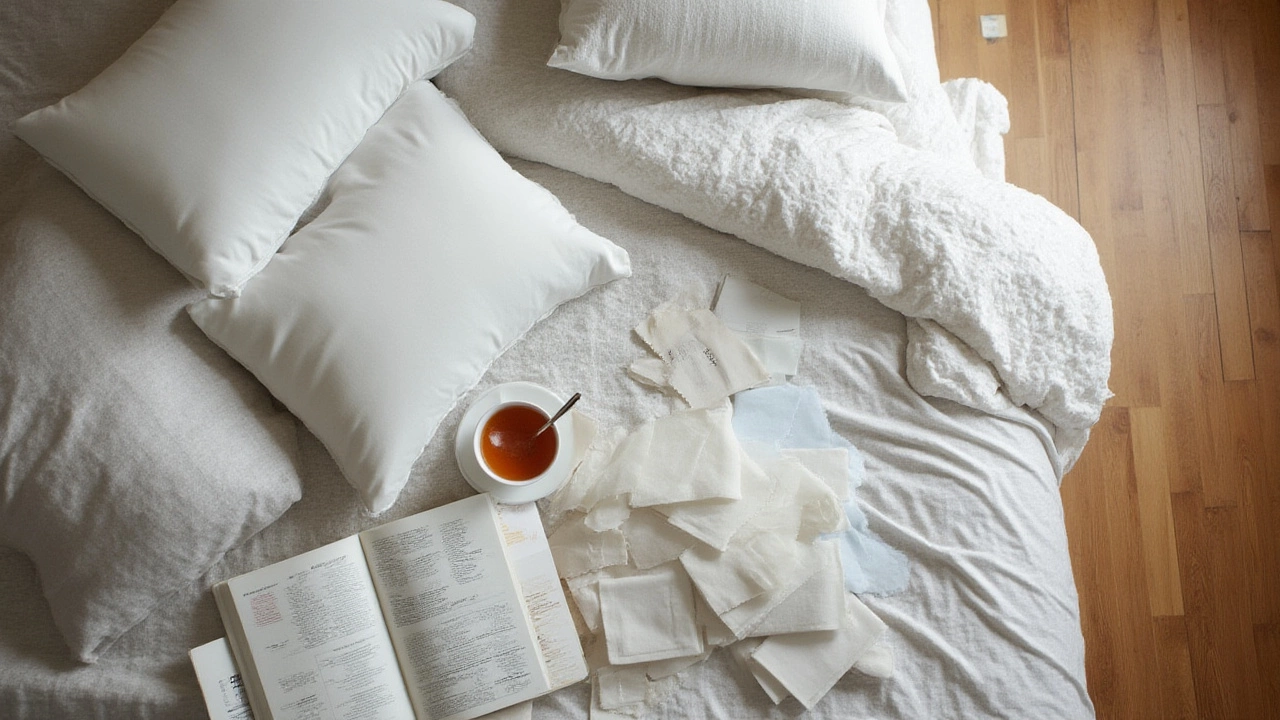What is Considered Bedding? A Guide to Everything on Your Bed
 Jul, 31 2025
Jul, 31 2025
Think your bed’s just a mattress and a bit of fluff? There’s a whole universe of stuff that people use for a good night’s sleep, and somehow, it’s all called bedding. It’s wild how many folks get confused about what falls under that label—wondering if the throw blanket on the edge counts, or if the decorative pillows are actually part of ‘bedding’ or just “nice-to-haves.” Turns out, bedding covers way more than bedsheets, and there are some legit reasons why it matters what goes on your bed—whether you’re chasing the best sleep or just want your room to look sharp.
Breaking Down Bedding: What Actually Counts?
Get this: bedding is not just sheets and a pillow. When people talk about bedding, they mean everything you put on your mattress for comfort, warmth, style, and practicality—except for the mattress itself and, sometimes, the mattress protector (that one’s debated depending on who you ask). Here’s what’s always included when you buy or talk about ‘bedding’:
- Sheets—these are the basics. Usually, they come as a flat sheet (the one that just lies on top of you or between you and the doona) and a fitted sheet (the one with the elastic corners that goes over your mattress). Some parts of the world, like New Zealand and Australia, often skip the flat sheet and just use a doona, but you’ll find them bundled in commercial bedding sets.
- Pillowcases—another non-negotiable. If it goes on your sleeping pillow, it’s definitely bedding. Decorative shams, maybe; sleeping pillows, always.
- Duvet covers—the handy sleeves that keep your actual duvet or comforter clean. Not to be confused with a doona (that's the fluffy inside; the cover is what you take off and wash).
- Duvets, doonas, and comforters—these go on top of the sheets and do the heavy lifting for warmth.
- Blankets and throws—a fuzzy extra on cold nights or just a splash of colour. If it’s used on the bed for sleeping or warmth, it’s bedding.
- Quilts—these often aren’t filled like a doona, but they’re layered, stitched, and can be pretty heavy.
- Bedspreads and coverlets—less about warmth, more about looks and a little extra heat.
- Pillow shams—those fancier, often decorative covers for pillows that still live on the bed, though technically some people see these as décor rather than practical bedding.
Now, some nitpickers separate ‘bed linens’ (sheets and pillowcases) from bedding, but let’s keep it real: everything you sleep under or on counts. Plus, if you head to many stores, bedding bundles include even more bits—like decorative cushions or mattress toppers.
The Layers of Bedding: What Goes Where and Why
Setting up a bed isn’t just about slapping everything down in no particular order. Each layer has a job, from hygiene to comfort. Let’s peel back those layers, one by one:
- Mattress Protector or Pad: Sits on top of the mattress. Not only does it work as a 'barrier' against sweat and accidental spills, but it boosts the lifespan of an expensive mattress. Top tip: grab a waterproof one if you’re accident-prone or have teenagers at home.
- Fitted Sheet: Keeps direct skin contact off the mattress/protector, and trust me, washing a fitted sheet is a lot easier than cleaning a mattress itself. Look for deep corners if you’ve got a thick mattress.
- Flat Sheet: Not a must—but many swear by the clean, smooth feel for sleeping. In hot climates, it often becomes the only cover you need.
- Pillowcases: More important than most people think; studies from the University of Manchester found pillowcases can trap more microbes than your toilet handle. Regular changes mean healthier skin and less sniffles.
- Duvet/Doona/Comforter: Here’s where regional differences kick in. New Zealanders might call it a duvet or a doona; Americans go for ‘comforter.’ What matters is that it’s usually either filled with synthetic fibre, down, or wool (NZ’s favourite, for good reason—wool breathes like a champ).
- Duvet Cover: The only thing between your sleeping sweat and the big fluffy doona. Makes life so much easier to wash too.
- Blankets/Throws/Quilts: Think of these as your backup for chilly nights or a little extra weight for anxious sleepers (weighted blankets are the rage right now – they can help with stress, according to some new sleep studies out of Otago).
- Bedspread/Coverlet: Final flourish. Coverlets lean more decorative, usually lightweight, while bedspreads are bulkier but do double duty for warmth and room style.
Your average bedding set won’t include every single possible piece, though. Usually, you’re getting fitted and flat sheets, pillowcases, and maybe a duvet cover if you buy a premium set. You’ll need to buy pillows, toppers, throws, and decorative extras separately.

Materials: Cotton, Linen, Wool, and Synthetics—What’s Best?
If you’ve ever stood in the aisle, confused at “1000-thread count Egyptian cotton” or “breathable bamboo-blend,” you’re not the only one. Bedding materials make a massive difference in how your bed feels, breathes, and lasts. Here’s what you need to know—and why it matters.
- Cotton: The classic choice, and for good reason. Cotton sheets, especially those made from long-staple cotton like Pima or Egyptian, are soft, durable, and get better with age. Average Kiwis wash sheets every two weeks, and cotton handles this like a champ.
- Linen: If you run hot or just want a lived-in, slightly crumpled look that’s effortlessly cool, linen is unbeatable. It’s moisture-wicking and strong (the Romans literally used it for currency, that’s how prized it was). Downside: it can feel scratchy at first, but gets softer with every wash.
- Wool: Wool makes an appearance in more than just heavy blankets. New Zealand sheep produce some of the world’s best bedding wool, and local manufacturers like Ecoya or Woolrest make duvets that keep you warm in winter and cool in summer because wool naturally regulates temperature.
- Bamboo: This one’s surged in popularity, especially in the eco crowd. Bamboo is antimicrobial, pretty cheap, and feels like a cross between silk and cotton. Make sure your bamboo bedding is made sustainably (sometimes these blends are heavy in chemicals).
- Synthetics: Polyester, acrylic, and microfibre make bedding cheap and wrinkle-free, but watch out—they trap heat and sweat more than the naturals. Might be a winner if you’re on a budget or don’t want to bother with ironing sheets.
The gold standard? For most beds, a mix of cotton sheets and pillowcases with a wool duvet suits New Zealand’s climate best. For luxury, look for percale cotton (it’s crisp and cool) or sateen (silky and shiny, but a bit warmer).
Bedding even has a role in allergies and skin health. Microfibre sheets are best for dust mite resistance, while natural fibres like cotton and wool have hypoallergenic benefits that reduce sneezing through the night. According to Allergy NZ, over 20% of Kiwis suffer some seasonal bed allergies—that’s a lot of nose-blowing in the mornings if you pick the wrong material.
Tips For Buying Bedding That Actually Feels Good
Nobody wants to spend a chunk of money and end up with a scratchy, hot mess. Before you buy bedding, here’s some stuff nobody tells you—but should:
- Count the threads, but don’t obsess over it. Anything from 250 to 400 for cotton is great. Above that, you might be getting fancy marketing, not better sleep.
- Always check the return policy: online bedding can look amazing and feel like sandpaper by the time it arrives (speaking from experience here).
- Double-check your mattress size—NZ has its own King and Queen sizes, which are different from American or UK sizes. Take a measuring tape or read up on sizes before buying that dream sheet set.
- Natural dyes are less likely to cause reactions if you have sensitive skin. The Sleep Foundation reckons harsh dyes can mess with skin, especially for kids under twelve.
- If you sweat a lot, skip the polyester blends. Look for moisture-wicking materials—wool or linen are standouts.
- Care matters. Linen loves a gentle wash and won’t go well in a hot dryer, while bamboo hates bleach. Always read that little tag, or you’ll be searching "how to fix shredded sheets" before you know it.
- Price doesn’t = comfort. Some $40 sheet sets at your local chain can be softer than high-thread-count Egyptian cotton with a big label. Feel and fit are king.
Bedding deals change with the seasons in NZ. The best time to shop for sheets, duvets, and pillowcases is February (end of summer—big clearances) or August (as stores switch for spring).

Bedding Stats and Surprising Facts
People spend, on average, a third of their lives in bed—so bedding isn’t just about pretty patterns. Here’s the real scoop on habits, costs, and trends, especially from a Kiwi perspective:
| Fact or Stat | Details |
|---|---|
| Average Sheets Washed (NZ) | Every 10-14 days (Canstar Blue, 2024) |
| Bedding Market Value (NZ) | $216 million NZD (IBISWorld, 2024) |
| Most Popular Sheet Material | 100% Cotton |
| Fastest Growing Bedding Trend | Linen and bamboo, up 22% in sales (2023-2024) |
| Biggest Bedding Purchase Month | February (end-of-summer sales) |
| Average Kiwi Bedding Spend | $175/year per household |
| Most Common Colour | White or light grey—easy to match and brighten rooms |
Here’s something that’ll make you smile: a study from the University of Otago in 2023 found that people with fresh-smelling, neatly made beds (think crisp cotton and natural fibres) reported 15% better sleep and were more likely to wake up in a good mood. Also, there’s evidence that having dedicated bedding sets for summer and winter can shave about $80/year off your power bill here, since natural fibres better regulate temperature.
There’s even a bit of etiquette—traditionally, in formal homes or guest rooms, you’d layer up with the works: flat sheet, blanket, duvet, bedspread, and matching shams. Most modern bedrooms just stick to the basics, with a well-chosen throw or two for a punch of colour or texture.
That’s what makes bedding such a big deal—it’s not just what you sleep on; it changes everything about how you sleep, how you feel, and how your room looks. Next time someone says “bedding,” you’ll know exactly what counts—and maybe you’ll treat yourself to an upgrade, because everyone deserves that ‘hotel bed’ feel, even if you’re just reusing your old pillowcases (just…wash them every week, please).